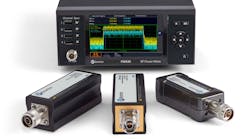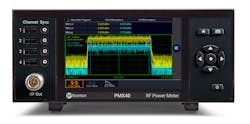Benchtop RF Power Meter Takes USB Sensors to the Next Level
For many decades, the traditional benchtop RF power meter has been a staple in engineers’ toolboxes. Ever present in both the lab and field, benchtop power meters (or wattmeters, as they’re sometimes known) are the go-to device for characterizing the performance of transmitters of all descriptions and from top to bottom of the spectrum. Historically, benchtop RF meters have used analog sensors as their input devices with the sensor connected to the measurement unit by an analog cable. Such instruments are quite durable and reliable, and they’re still widely used.
Some years ago, USB RF power sensors appeared, representing a new approach to power measurement that encapsulated most of the functionality of the benchtop meter in a device that took the benchtop instrument out of the equation. Instead, the USB RF sensor (which is slightly larger than the analog sensors) delivers its data to a computer. It means a different user interface—rather than the buttons, knobs, and meter movement (or digital display) of the benchtop instrument, a graphical user interface (GUI) on the computer screen displays the sensor’s data. The setup involves software that either the user must develop, or the USB RF sensor vendor must supply.
Perhaps no vendor knows more about RF power meters and USB RF sensors than Boonton Electronics. Boonton believes the industry is ready for yet another new approach to power measurement: It would retain the best aspects of the traditional benchtop instrument and USB RF power sensors, but combine them to enable new possibilities for RF power measurement.
Enter the Boonton PMX40 RF power meter, which differs from traditional instruments in that it uses USB power sensors as opposed to the old analog sensors. That’s significant in several ways. As a benchtop RF power meter, the PMX40 still captures, displays, and analyzes peak and average power in both the time and statistical domains.
The front panels of many traditional benchtop RF meters are laden with knobs and buttons in addition to a small display. Further, older instruments typically provide inputs for only one or two analog sensors. In contrast, the PMX40’s most prominent front-panel feature is a 5-in. multitouch display, providing a more modern UI. Not only that, but it accepts inputs from four USB RF power sensors for multi-channel measurements on any sort of RF signal, be they continuous wave (CW), modulated, or pulses.
In cases such as LTE, 5G, or Wi-Fi, the PMX40 is easily configured for multiple-input/multiple-output (MIMO) measurements. It’s also able to perform such measurements in synchronized fashion, giving users a common time reference across all four channels. This makes it easy to determine whether MIMO signal paths are properly timed.
Traditional RF power meters historically have a “reference output” that enables users to mitigate interconnect uncertainties imposed by the analog cables connecting sensors to the meter. Not only do traditional meters require an initial calibration, but as ambient temperatures change and cables are physically moved, users need to stop taking measurements to recalibrate. The all-digital communication between meter and sensor in the PMX40 makes calibrating out cable drops unnecessary; the USB RF power sensors are essentially “plug and play.”
But Boonton incorporates a “test source” to verify basic operation of USB RF sensors as a “sanity check” to determine whether the USB sensor is behaving as expected. Don’t need the meter for a given application? Then simply use the USB RF sensors independently through a robust application programming interface (API) or complementary UI to gain access to the full palette of sensor features and functionality.
USB RF Sensors to Match
In some ways, an RF power meter is only as good as the sensors it’s paired with. Fortunately for users, Boonton offers several USB RF sensors that seem tailor-made for the PMX40. Chief among them, the RTP4000 and RTP5000 sensors offer what Boonton calls “real-time power processing.”
Power meters and USB sensors must intermittently stop acquiring samples to process those they have collected. There are also acquisition interruptions for adding calibration factors, scaling, or formatting for display. With the exception of Boonton, these processes are performed sequentially. During these periods, the meter/sensor isn’t collecting data. Something you want to know about may be missed entirely. For example, heating of high-power amplifiers can cause anomalies such as dropouts or droop. Boonton’s real-time power processing performs all of those acquisition-interrupting operations virtually in parallel, avoiding sampling interruptions and causing no measurement latency or gaps in data acquisition.
The RTP5000 sensors also offer industry-leading performance on several fronts. At an effective sampling rate of 1 GS/s and 100,000 measurements/s with virtually continuous operation, they enable time resolution of 100 ps. In addition, those 100,000 measurements are of peak, average, and minimum power. So, for a burst or pulse signal, you’re measuring the noise floor, the top of the packet or burst, and the average power. Or, you can gate measurements to get peak, average, and minimum power of the burst alone.
Other best-in-class specs for the RTP5000 USB RF power sensors is a video bandwidth of 195 MHz and rise time of 3 ns. If you’re measuring, say, Wi-Fi 6 signals with bandwidths of 80 and 160 MHz, you’ll need most of that 195-MHz video bandwidth to make accurate peak-power measurements. The fast rise time matters for pulse signals and capture of fast leading edges.
For budget-conscious USB RF sensors, Boonton’s CPS2000 family also pairs well with the PMX40 RF meter while also offering best-in-class performance. The sensors have both USB and LAN (with Power over Internet) connectivity, so if you’re not using them with the PMX40, they support independent operation.


